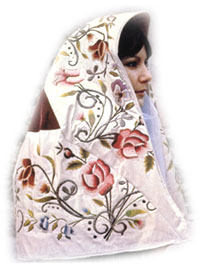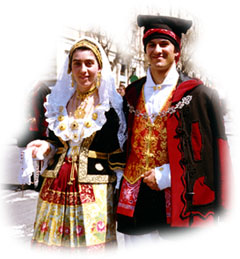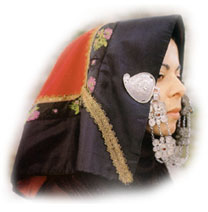 |
|
The scarf or the shawl that covers the
women's shoulders is often the result of years of work,
and pays testimony to an ancient art that is slowly being replaced by modern technology and
therefore runs the risk of disappearing forever.
Fortunately this art can be still
admired at the "Sagra di Sant'Efisio", at the "Cavalcata Sarda", at the "Festa del Redentore" in
Nuoro and on other occasions such as the grand "Matrimonio Selargino" (a traditional
Sardinian wedding) which is celebrated every year in the month of September in Selargius, a
town near Cagliari.
During these festivals one can admire the actual costumes that were worn during festivals a
hundred or more years ago. |
The grandchildren
and great grand children of the original owners
have conserved the costumes carefully and nowadays they wear them with pride during the
most important festivals.
These costumes were made using
ancient and mysterious techniques, that required not only a great deal of skill but also
knowledge. For instance, the materials were dyed using natural plants and grasses; each
family had its own secret formulas and techniques which were jealously guarded, and passed
on from generation to generation within the family.
There are still many secrets and surprises to be revealed by the costumes. |
|
 |
 |
|
In fact the most
curious observers would enjoy noticing the differences between the typical costumes of the
mountain areas and those from villages near the sea.
They could try to distinguish,
among the thousand of female costumes, those which women used to wear on their wedding
day and those which the widows wore.
They may also try to understand if a costume belonged
to a rich person or to a person of modest means which is not always easy to do.
|
|

